Dublin in the early 1950s is a world unto itself turned inward. Dr Quirke is a pathologist who observes much and suspects more. When a road accident victim’s corpse is examined he finds a contusion on the temple that is inconsistent with the car crash. Musing follows. In time, he mentions his doubts to the Inspector Hackett of the Serious Crimes Squad who noses around and finds unpleasant emanations. This is the seventh entry in a series and it is tired, but perhaps complacent is the right word: ‘If I write it, the reviewers will praise it.’ He did and they did.
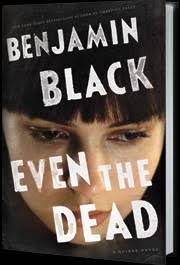
Though the spring weather is benign, the choking conformity of Maxima Catholic Dublin is inescapable. All in Dublin is more Catholic than the Pope. It is certainly more Catholic than the Rome of the time. The Bishop’s Palace is the seat of power in Dublin, not Tithe an Rialtais, the large Edwardian building enclosing a quadrangle on Merrion Street wherein dwells the Taoiseach by which we once walked.
There is only one escape permitted from this suffocating pall and that is alcohol. Frequently in Quirke stories, and no doubt in 1950s Dublin life, the pregnancy of unmarried women is paramount. Moreover, every thread, however long and ravelled, eventually traces back to the Catholic Church and its baleful tentacles.
These books are very well written and the picture of Irish life seen through Quirke’s eyes is to travel back in time. Yet in these books there is precious little detection, no police procedure despite Hackett’s occasional plod, and no mystery. Much is also predictable, as Quirke’s sexual conquests. As soon as a women is introduced into the story, we know she will soon succumb to his charms.
Instead we have Quirke, holder of a prestigious and authoritative position, a highly trained and accomplished medical doctor, a widower, father of a bright grown daughter, comfortable of income, handsome and attractive to women, who spends nearly every minute feeling sorry for himself in a self-imposed melancholia where he wallows for pages and pages, smoking cigarette after cigarette, drinking drink after drink. Evidently his pathologies did not involve lungs or livers.
Instead of detection we have meals, drinks, cigarettes, meals, drinks, cigarettes, meals….. On it goes. Yes, the prose is polished and the observations of life’s details exact, but repetitive and inert. There seems to be neither point nor purpose to the the prose. Some of the characterisations are profound, like Quirke’s terminally ill brother but have no place in the plot.

There is no doubt John Banville, Benjamin Black’s after ego, can write. The portrait of the victim’s father is striking and sympathetic. The contrast, however, is the government official whom Hackett interviews, who is little more than a cartoon character, flustered by the simplest question. Banville has respect for the father and none for government officials and it shows as he makes up the reader’s mind. Take that all those who work for the government, including those who uphold the intellectual property and copyright laws that secure Banville’s income. all those who regulate and maintain the internet services that provide a platform for his novels, all those who police crime and who had to deal with IRA on the border for a generation, all those who make difficult decisions about troop deployments on UN Peace Keeping missions, these are all clots!
I also found the reference to the Spanish Civil War confusing. The International Brigades were certainly there but the specifics mentioned in the story did not compute.
‘Men into Space’ (1959-1960)
IMDb metadata: run time per episode in 26 minutes, rated 8.1 by a paltry 122 cinemitizens.
A one-year television series in thirty-eight episodes from the United States depicting space flight pioneering with respectful attention paid to the science and technology. Willy Ley would have approved. Maybe he did. It stars everyman William Lundigan.

And he alone is the constant through the episodes. No other player is listed for more than eight outings. That may partly explain its failure, not enough characters to develop audience identifications, together with the lack of dramatics from calm, cool, collected, and sometimes nearly catatonic Bill. The tone is realistic and the presentation emphasises the difficulties. Space flight is hard enough without zombies, meteors, or John Carradine.
The drama emerges from the divergences among the crew, and occasionally from mechanical elements. Some of the crew are determined to complete the mission even at high risk, and others are more cautious. Everything is being done for the first time, and some of the equipment fails. Think Apollo 13. Think low-bid contractors.
The series was made with what appears to be the unstinting cooperation of the USAF, as noted in the terminal screen acknowledgements. These Saturn rockets are military without a doubt.
In 1958 President Dwight Eisenhower created NASA to explore space. There must be quite a story there of Ike wresting some of the missiles from the generals. But who mistrusts generals more than a one-time general, and who better to convince Congress likewise than that same general.
No doubt this creation was part of a policy to encourage the Soviets not to use space for military purposes. But of course there must have been some serious cooperation between NASA and USAF that continues today. Those rockets grow on money trees in the defence budget green house. No doubt there have been occasions when the USAF made a bid to take over from NASA, too. These bureaucratic fights would be fascinating studies in themselves.
This series might have appealed to the Air Force as publicity for its sole-agent claims to space. Though the references to an enemy ‘them’ are few. Indeed in one episode the safe return of Bill himself is only possible with the cooperation of a Russian tracking station. No doubt when the script writers get bored they will throw in some sabotage, and that friend of the jaded writer, the meteor, but not in the early going.
Even so it is notable that each of three episodes seen so far end in failure. The Moon orbit is aborted and the whole crew returns safely. The Moon landing is compromised and one crewman dies on the Moon, and the rest have to leave before completing the mission. Ditto the third, another injury truncates the it. The program, a cynic might say, was creating a climate of low expectations for space exploration.
 Man down!
Man down!
The key is so low that the first steps on the Moon are nothing much. The door opens, down the ladder they go and start standing around waiting for the director to cue them. No dramatic pause before the step onto the surface. No finely calibrated remark. No excitement.

No speeches and no flag. Neil Armstrong got no tips from this scene for his step into eternity.
While there is a revolving door of characters the sets are of great verisimilitude for the day, thanks no doubt to the Air Force. The acting is fine, the more so considering how quickly each episode was made. Maybe not in one-take, but close to it. The worried wives, look very worried. The anxious generals on the ground look anxious. The stressed flyboys look stressed. By the way, the ubiquitous Australian Michael Pate appears in one episode.
The one mistake is in the portrayal of the representatives of the media of the day as sober, sensible, and civil, but then maybe they were back in those days. Certainly today no self-disrespecting ABC journalist would fail to badger the worried wives with questions about death, children about absent fathers, generals about incompetence, and so on. Why let the dust settle when stirring it up goes on the resumé.
Like the acting and realism, the special effects with models and travelling matte are far superior to many a B-movie reviewed on this blog. Free-fall in the cabin is fun to watch. In space there is no flame from the rockets. The EVA astronauts are floating in the ether.
The Mind Palace has no entry for this program from the time. It was programmed against ‘The Adventures of Ozzie and Harriet Nelson’ and ‘The Price is Right,’ so I guess our boob tube was on the Nelsons in 1959-1960.
‘Escape from Galaxy 3’ (1981)
IMDb metadata is this: 1 hour and 32 minutes of treacle, rated 3.2 by 277 cinemitizens who confessed to seeing it.
First there was ‘Starcrash.’ and then when it seemed Italian Sy Fy films could not get worse, the same production crew that made it came out with ‘Escape from Galaxy 3,’ from which there is no escape. The production liberally plagiarised the special effects, vista shots, and costumes from the earlier film, and this story, such as it is, starts where ‘Starcrash’ (mercifully) ended.
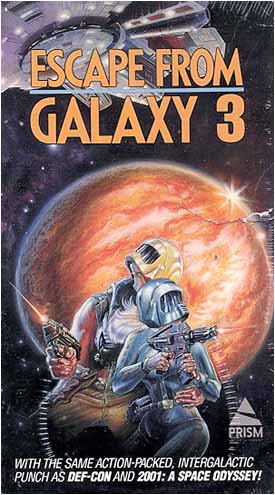
What is the set up? Princess Lolo and King Dad are in for trouble when Liberace shows up dressed for the Newtown Mardi Gras right down to sparkle in his beard.
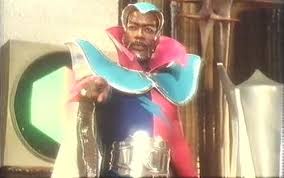 Looks like he fell off a float.
Looks like he fell off a float.
He has cosmic mega candelabras and blasts them. He did not come in peace. He came in sparkle. Since he is styled ‘King of the Night,’ the fraternity brothers wondered if he was searching for the Queen of Night from Mozart with her very, very high Cs. Should be able to hear her anywhere in the galaxy when she hits it.
Yes, this is yet another Italian Star Wars exploitation. It goes to the bottom of a long list.
Lolo with Seia, her bodyguard, flee. Liberace pursues. They flee some more. Liberace pursues some more. When he gets close they fire their puny candlesticks and he replies with his cosmic mega candelabras that destroy whole planets that get in the line of fire. This takes forty-five minutes or five on Very Fast Forward, best friend of the obsessive film reviewer.
Desperate for an espresso, Lolo and Seia land on Earth, 20,000 years ago to tank up. Yep. the fraternity brothers recognised the Italian peninsula for what it is, a phallic symbol. So do the travellers. Once there they learn from the birds and bees. This couple of losers did not know what those bits were for back home. Now Seia takes his duties as Lolo’s body guard to new…. No wonder Liberace thought it was time to exterminate them. There follows about forty-five or five minutes of frolicking. Old Liberace has been forgotten. Oh, sure.
Until he arrives with his mega cosmic candelabra and starts blasting Earth, then the script remembers him. The natives blame Lolo and Seia for making God mad at them, and so they should. A soccer riot follows and Liberace grabs Lolo and Seia, though why he wanted these two stick figures is not clear. They face off, and — whoa! — Seia burns Liberace to a crispy critter with his laser eyes. ‘Laser eyes?’ Yep. Saved those for the end.
Lolo and Seia decide to stay on Earth and start Italy.
The end.
In a word: terrible.
The Italian title makes it sound far better than it is, namely, ‘Giochi erotici nella terza galassia,’ which according to Siri translates as ‘Erotic games from the third galaxy.’ There is no science and the fiction is incoherent, bland, and predictable (except for those laser eyes, which he must have borrowed from Superman and augmented them somehow).
It was also released in English-speaking markets as ‘Starcrash II’ to warn off movie goers. It worked. Other Italian imitations of ‘Star Wars’ include the aforementioned and difficult to forget ‘Star Crash’ (1978), ’Star Odyssey’ (1979), ’War of the Planets’ (1977),’ ‘The Humanoid’ (1979), and others I have successfully forgotten.
Quatermass 2 or II: Enemy from Space’ (1957)
IMDb metadata is 1 hour a 25 minutes, rated 7.0 by 2773 cinemitizens.
When Quatermass’s moon project is starved of funds, he goes to Whitehall to bludgeon bureaucrats into stumping up the dosh. This method has always worked before so off he goes. Meanwhile, his crew watch the gentle ascent of a flock of meteors.
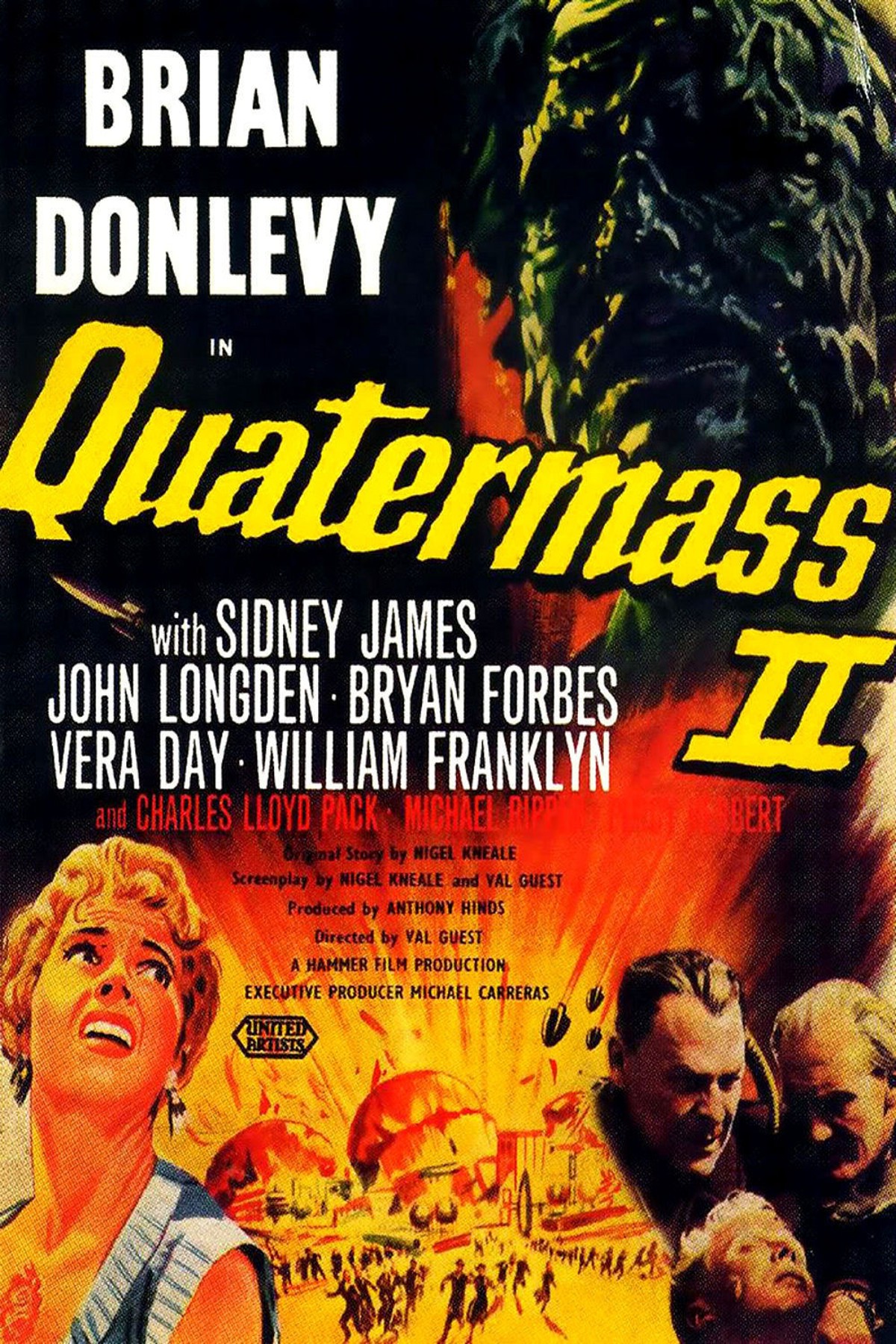
Strangely in London no one this time is moved by Quatermass’s bluster and bullying. Quatermass draws the only conclusion possible, eh Erich. Yep, the aliens are at it. That, by the way, would explain a lot about Whitehall decision-making over the years.
After shouting at his subordinates for a while, Prof Q pays attention to the meteors, and now having nothing better to do, he scouts the location where they fell. Well, no, he cannot do that because it is fenced off in the manner of a German death camp. Moreover, the perimeter is patrolled by some very silent, icy, and heavily armed guards in get-up that is un-English.
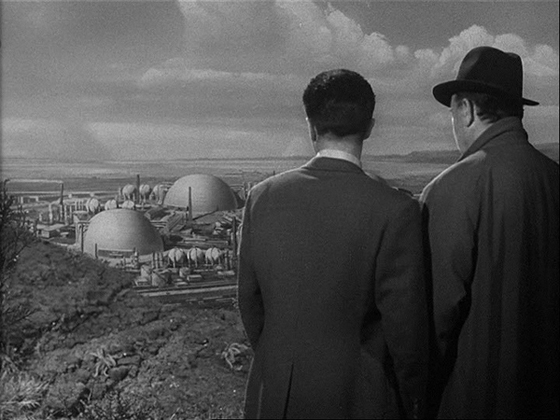 A conveniently located viewing platform offers perspective to the Prof.
A conveniently located viewing platform offers perspective to the Prof.
These guards spirit away the hapless assistant who drove Quatermass to the locale, and as Quatermass goes all Alpha Male on them, one steps forward and hits him with the butt of a gun. Down went Prof Q to the cheers of the fraternity brothers. ‘About time someone told him where to get off for assigning all that homework over Easter,’ they cried! Aside: all profs look alike to the fraternity brothers.
The meteors are eggs that hatch out a gas that infects humans, turning them into slaves. The word ‘zombies’ is used once, but oddly not the word ‘Republicans.’ The slaves built in a day or two the great complex Quatermass espied before his lights went out. When he recovers he rushes about, partly to find his assistant who has the keys to the WC, and to divert funding from this mystery project back to his own KPIs.
More doors are slammed in his face. Ah ha! It is a vast conspiracy. Yep the ‘Invaders’ (1967) have been at it a decade before Roy Thinnes came along, and most positions of authority are occupied by Republicans aka aliens! Look at those little fingers! Proof positive!
There is a fabulous scene where a delegation is being shown around the facility and a parliamentarian wonders off and is slimmed! Slimmed! There are many striking touches like this in the film. But consider what does it take to slime a politico.
Sid James appears as a sotten journalist who telephones in the story from the local pub, only to be mowed down by the aforementioned security guards. Witnessing this murder, shakes up the locals and to calm down they watch ‘Frankenstein’ (1931) and get an idea. They gather with torches, pitchforks, straw hats, darts, and other accoutrements of rural life to march on the mystery site.
Mayhem ensues around a Shell Oil refinery. Quatermass just happens to arrive to boss everyone around. Meanwhile, his deputy, Bryan Forbes, launches the rocket and somehow this disconcerts the alien protoplasm. Forbes went behind the camera to direct later in his career.
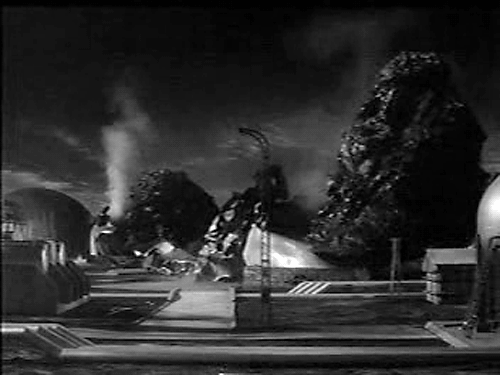 The protoplasm which looks like that of the earlier ‘Quatermass Experiment.’ He needs an autoclave in his laboratory to clean up and prevent such growths.
The protoplasm which looks like that of the earlier ‘Quatermass Experiment.’ He needs an autoclave in his laboratory to clean up and prevent such growths.
At no time does Q try to negotiate with the amoebas. A big BOOM follows. Catastrophe averted, yes, but Quartermass strides off to prepare for the next one.
The Quatermass Franchise grew from Nigel Kneale’s typewriter first as serials on the BBC and then films. He was a very fine writer, some of whose other works are reviewed elsewhere on this blog. This script was filmed as a television series but it did not survive the BBC policy of taping over past productions. The director was Val Guest, who once again offers a masterclass in pace.
This outing presages much to follow in its paranoia, the mark of Cain on the humans who have succumbed to the aliens, the James Bond shoot out in the refinery, but also draws on the established tropes with those meteors. The obvious compareson is ‘Invasion of the Body Snatchers’ (1956) which stole much of this film’s thunder in the North American market.
Scuttlebutt on the interweb street says Kneale and Guest argued about the character of Prof Q. Kneale wanted an avuncular English eccentric, but Guest wanted energy and tension in the part, and the producer wanted to sell the finished movie to the American market, so he wanted an American in the lead. Some of the more inane remarks, and that is a competitive field, on the IMDb blame Brian Donlevy, who played Quatermass, for the characterization, but it is obvious to anyone but a retard that the director did it. I guess the blunt, belligerent, brash, bossy, bullying, boorish, and bellicose Professor Quatermass was their idea of an American after having studied Dwight Eisenhower.
‘Mesa of Lost Women’ (1953)
The IMDb metadata is 1 hour and 10 minutes of Dali time, rated 2.5 by 1099 cinemitizens.
In the middle of El Muerte desert in Old Mexico Uncle Fester is conducting experiments to recreate Gale Sondergaard! ‘No chance,’ said the fraternity brothers, ‘she was one-off.’ Fester is splicing genes from an unlimited supply of spiders and an unlimited supply of Hollywood wanna-be starlets. The result was Tandra Quinn aka Tarantella! There were many others such women with Fester but only she had a name in the cast list. The others are termed, with admirable imagination, ‘Lost Woman.’ About ten of them. They were not even distinguished by a number like Lost Woman 1. The fraternity brothers hoped to find them when the lights came on.
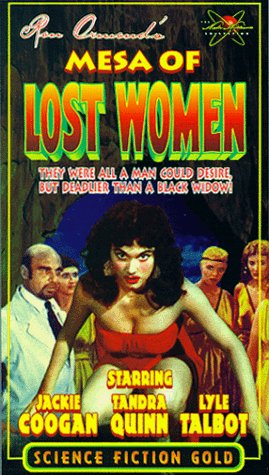
Two bumps upset Fester’s apple cart laboratory. First he awarded a nationally competitive research grant to a scientist to join his lab. Fine. When this aged Post Doc shows up, turns out, he doesn’t like this kind of gene splicing. What a sissy! He even recoils from the fifty-pound spider Fester keeps as a pet, an early experiment that did not work out quite right.
Second, an airplane crash lands on the mesa and brings onto the Rock of Otranto a mixed group of passengers and crew. They blunder around. Smoke cigarettes. Blame each other for the crash. Decry Republicans. And notice, slowly, that their number is being diminished.
Fester has sent his little men after the intruders. ‘Little men?’ Yes, a by product of splicing the spider women is the production of shrunken dwarfs as their paramours and ….. [Here the veil is drawn.]
The film was a boon for Hollywood’s dwarf population some of whom got a day’s work out of it. Likewise for the wanna-be starlets. Neither dwarf nor starlet had any lines. These human spiders, as Fester likes to call them, communicate by telepathy. Ergo, the actor’s minimum wage did not have to be paid.
This set-up has at least as much potential as ‘The Wild Women of Wongo,’ reviewed elsewhere on this blog, but the execution undermines any prospects it might have had. Though admittedly it is better than that film but then so is a blank screen.
It is told as a flashback within a flashback and the characters are undifferentiated so that the audience — me — was never quite sure who was whom, apart from Fester. The oil man who finds the couple wandering in the El Muete desert and the airplane pilot were identical twins on camera, but in the credits different guys. Oh.
Though the second scientist escapes from Fester’s Mesa later he just happens to the on the airplane that crashes on to the mesa. How easy is the scriptwriter’s life with such coincidences.
Equally coincidental Fester’s oriental servant is one of one of the passengers on that plane, though he is not a dwarf. How he got from the laboratory in one scene to sitting on the airplane in the next is down to the magic of the scriptwriter’s typewriter.
Within minutes of leaving the wrecked plane the just married bride among the passengers leaves her husband and goes into the bushes with the pilot for a anatomy lesson. She wants him to understand her. He does.
That second scientist, when he fled put miles between himself and the mesa, yet by coincidence he found Tarantella in the bar he walked into for a drink. After he shot her dead, she got up and left. Spider women never die! He then boarded the airplane to….the Mesa of Lost Time.
Yet later they all die in a fire started by our hero, whoever that was.
Throughout the mish-mash are interspersed for no discernible reason close-ups of Fester, perhaps he is using You Telepathy Tube, but who knows. There are also a number of equally pointless close up of the wanna-be’s larded into the proceedings. The fraternity brothers will explain those transactions to anyone who writes in and asks nicely. The dwarfs don’t get many close-ups.
There is an intrusive musical score that sets teeth on edge. It consists of three chords on a guitar repeated without purpose or end, punctuated now and then by a vase falling on a piano keyboard. Half-way through the fraternity brothers formed a lynch mob and set out to find the composer.
The direction is haphazard, if existent. The production values came fo Filene’s Basement. Fester is too low key to laugh at. Most of the cast are described on the IMDb with this phrase, ‘little remembered.’ Yep. For most of them this film was the apex of their career.
This movie is another example, among many, of the overlap of the genres science fiction and horror. There is ostensibly science in Fester’s lab explained with dialogue, but the results are horrible. Well not so horrible as to require expensive make up and costly special effects. Though, admittedly, the finger nails take seeing.
‘12 to the Moon’ (1960)
Internet Movie Data base metadata: 1 hour and 15 minutes in Dali time, rated 2.8 from 819 cinemitizens.
The International Space Organisation represented by silent film star Francis X. Bushman (born in 1883) proclaims ‘the greatest day in human history’ with the launch of the ISO ship and crew for the Moon! ‘All nations have contributed’ to this ‘Earth shattering event,’ he says. FXB has other Sy Fy from this era on his CV.
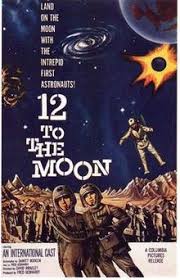
The twelve are diverse, including two women, who are not demeaned or deprecated, as is so common Sy Fy of this era and ilk. They go about their business without sneering by any of the men, or — what is always worse — efforts at comic relief at their expense.
The security is tight. Each crew member has to say his or her name! Wow! That would stop the fraternity brothers most days of the week, without a peek at the driver’s license.
We have a Frenchie, a Germanian, a Brit, a Jap, a Swede, a something else, a Nigerian, an other, and a Pole resident in Israel, and a Russkie. This Russkie is played by someone born in Russia, namely the Saint cum Falcon, showing the wear and tear of the bottle. The leader of the pack is Yankee Doodle.
Smooth sailing does not last long. Members of this handpicked crew soon fall to bickering among themselves, per the script, and then they have to duck meteors, the scriptwriter’s friends. Whew! Still they make it to the Moon, where their number quickly diminishes. I seem to recall one of them falls down a hole. Gone. Two others wander off. Gone. Another gets clonked by a blunt meteor. The crew is getting less international by the minute.
Then from the ship’s computer comes a string of meaningless characters, which Yankee Doodle immediately recognises as Moonshine. Ooops, just kidding. He says they look Oriental and since one Oriental looks like another he orders the Jap to translate. Being a smart fortune cookie she quickly learns this Moonie lingo and translates. The message is: ‘Scram! But leave the cats.’
Cats? Yes, they brought two cats for scientific reasons which are too delicate to reveal on a family blog. (They also brought a cocker-spaniel to sniff their luggage.) Evidently the ‘Cat-Women of the Moon’ (1953) wanted company. (This gem is reviewed elsewhere on this blog.)
We never see or hear the Moonies, hiding as they are deep underground to save on the production budget. As if! Maybe this is a trick to ruin the mission by one of the crew, shouts the hysterical genius. He is slapped down with his own slide-rule. But it turns out, in a twist, that the Frenchie is trying to scuttle the mission because he is one of ‘them,’ though the Russkie is not. Those who figure this out get a giant No-Prize. The geriatric Russkie is no match for the geriatric Frenchie, and Yankee Doodle has to whack him.
They lam off the Moon only to find the Earth a snowball. Yes, the Moonies want to watch ‘Ice Age’ (2002), not reviewed anywhere on this blog. What will Twelve Minus do? Of courses, blow it up! Huh?
They resolve to build an atomic bomb, fly over a handy volcano, drop the bomb down the spout, and the explosion will restart the carburettor, or something. This is a risky mission so the two who are to do it are bitter enemies, who have a reconciliation just before they ride the bomb down, like Slim Pickens. (You either get it, or you don’t.) Two more gone to dust.
That fixes that. Twelve went away and seven came back. I lost count, as did the director.
The end.
This a work of fiction without the science. The absence of anything remotely resembling scientific knowledge is complete. The ship exhaust flames in the void of space. The cats breathe on the airless Moon’s surface. The gravity is one-sixth so that of Earth, some characters trudge along as though under the sea. When the explosion in the volcano occurs we get shots of solar flares. Though they are always putting on and taking off crash helmets, there is no glass in the front of the faces because it is unnecessary thanks to hocus pocus. The list goes on. Since the film presents itself as a near documentary account such errors are laughable.
But even more amusing than these mistakes is the apologies for them in some of the User Reviews on the IMDb. Usually I skip these comments because so many of them are egotistical drivel, but since few of the critics linked to the IMDb, and none of the ones I have learned to respect, comment on this sludge I scanned the User Reviews. It was a refresher course in why I do not do this. Several scored it as 10 because of the gripping story. Oh hum. A couple of others praised its scientific acumen. No doubt a climate change denier. ‘Stop!’ I cried, and I did — stop.
Then there is the stage craft. In space we see the black pole on which the spaceship is stuck as it passes in front of the star matte. In the first shot of the Moonscape there is someone walking in front the light casting a shadow on the distant cliff face. Boom mikes occasionally intrude at the top of the screen. The actors sometimes speak so slowly it is clear they are repeating lines just recited to them.
It is also a creature feature that spares the expense of having a creature. We never see the Moonies, though the fraternity brothers suspected the Cat-Women were the culprits.
All in all though it is a crowded field, it is a contender for the worst of Sy Fy.
‘Revolt of the Zombies’ (1936)
IMDb metadata: 1 hour and 5 minutes, but it seemed longer, rated 3.2 by 1241 cinemitizens.
The set-up is complicated for such a short pot-boiler, but here it is. During the Great War a French Army is being overrun by Huns, when….a regiment of Colonial Troops from Cambodia appears and proves impervious to German steel and lead. France is saved! A dead soldier cannot be again killed, and these are zombies, the animated dead.
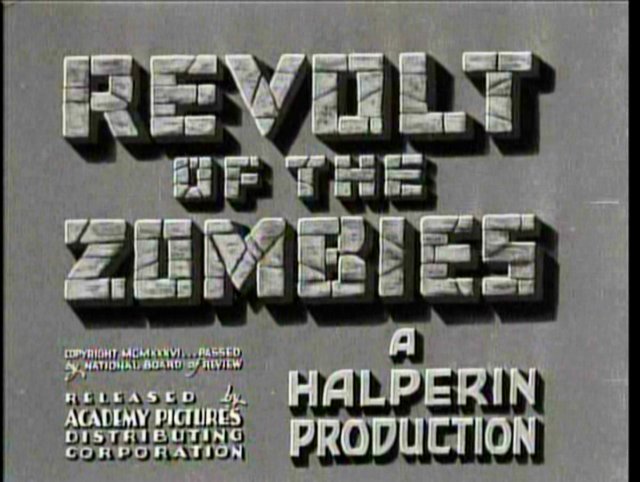
They were raised from the dead for just such an emergency by a Cambodian priest who parades around the winter trenches in a loincloth.
In a show of gratitude the priest is murdered because such zombies could mean ‘the extinction of the white race,’ cries one general to another.
While Woodrow Wilson was re-drawing maps at Versailles, these generals convene an international meeting for the purpose of eradicating the zombie threat to ‘the white race.’ Managers are keen to do this since it is a waste of ammunition trying to kill the dead. The plan is for an International Expedition disguised as archeologists to find the heart of Zombiedom at Ankgor Wat and kaboom it. A few back projections from a real expeditions suffices to set the scene.
Indiana Jones was too young to get a visa so instead they have assembled Dean Jagger with hair, Frail, and Beau among others. The latter two are as one whenever possible and a few times when it seemed impossible, according to the expert opinion of the fraternity brothers. Yet Dean professes his love for Frail, who is kind to him, always a bad sign, kindness like that. He does not take it well.
By now Dean, since he cannot be one with Frail, has been swotting the books and has discovered the secret incantation that saps everyone of their will — McKinsey Speak! The mumbo-jumbo of Key Performance Indicators, 360 degree reviews, deliverables, and the living dead are conjured, as can be seen in any meeting room nearby.
There in front of the back projection Dean has his way! The fraternity brothers took copious notes.
But Frail still does not love him! There is no money back guarantee with McKinsey-Speak so Dean falls for the oldest trick in Eve’s book. He renounces his mystic powers so that Frail will love him for what he is: A dope.
Even as the pompous Dean does on about what a noble thing he is doing, relinquishing his supernatural powers, all for Frail, those Cambodian zombies in the back projection revolt against his will-sapping tyranny. End of Dean, hair and all.
The end.
Good thing Woodrow was busy with the crayons, because if he had got wind of any of this plan, he would have banged on about applying the Fourteen Points to zombies. (Woody never knew when to quit.)
However, the scriptwriter would have done well to borrow a map from Woody since this scenario starts in a battle along ‘the Franco-Austrian frontier.’ Huh! No such place. The Austro-Hungarian Empire of the Great War was a vast conglomeration in central and southern Europe a long way from France.
The border between science fiction and horror is permeable and one genre informs and influences the other. Thus it happens that horror movies like the one at hand turn up in searches for Sy Fy. Seeing it on a list one night, I chose it because the length suited the nocturnal schedule. I watched a very poor print on You Tube, though subsequent investigations found a better one at the Internet Archive.
The commentariat has a lot to say about this film, despite its well-deserved obscurity. It attracts attention because by some measures it is the second zombie film to come from the Dream Factory. The first was ‘White Zombie’ (1932), reviewed elsewhere on this blog, which was a commercial and critical success. No wonder: it starred Bela Lugosi. ‘Revolt of the Zombies’ came from the same production crew in the effort to recapture the magic and the money, and recycles some scenes from the earlier film, but lacks the verve, plot, and — most of all — Lugosi. These two films gestated a plethora of subsequent zombie movies and in time the concept of the zombie evolved to meet the needs of scriptwriters.
‘The concept of the zombie’ is something, along with much else, to which the fraternity brothers have heretofore given no thought. That time is over.
A zombie is a corpse raised from the dead and animated but without human qualities, like greed, emotion, hate, stupidity, and the other loveable features of our kind. They are directed by the mind of another, like robots. Indeed the word ‘robots’ is used in ‘Revolt of the Zombies’ about the Cambodian zombies in the trenches. That is per the ‘Oxford English Dictionary,’ which finds the word ‘zombie’ used in English in 1819 by a traveller returned from Brazil who observed Voodoo rituals.
Wikipedia assures the gentle reader that zombies play no part in ‘the formal practice of Voodoo.’ ‘The formal practice of Voodoo,’ that wording set the fraternity brothers to wondering about the informal practices. Or is Voodoo just about dolls and pins? (Is this the place to confess my own flirtation with a doll and pins?)
It is absolutely obvious that the Cambodians whom Dean enthrals are alive, and have not yet ever been dead, ergo proclaims the commentariat they are NOT zombies. Tricky. They have no wills and are mentally enslaved, but they have yet to be dead so how can they be undead. This circle goes around and around.
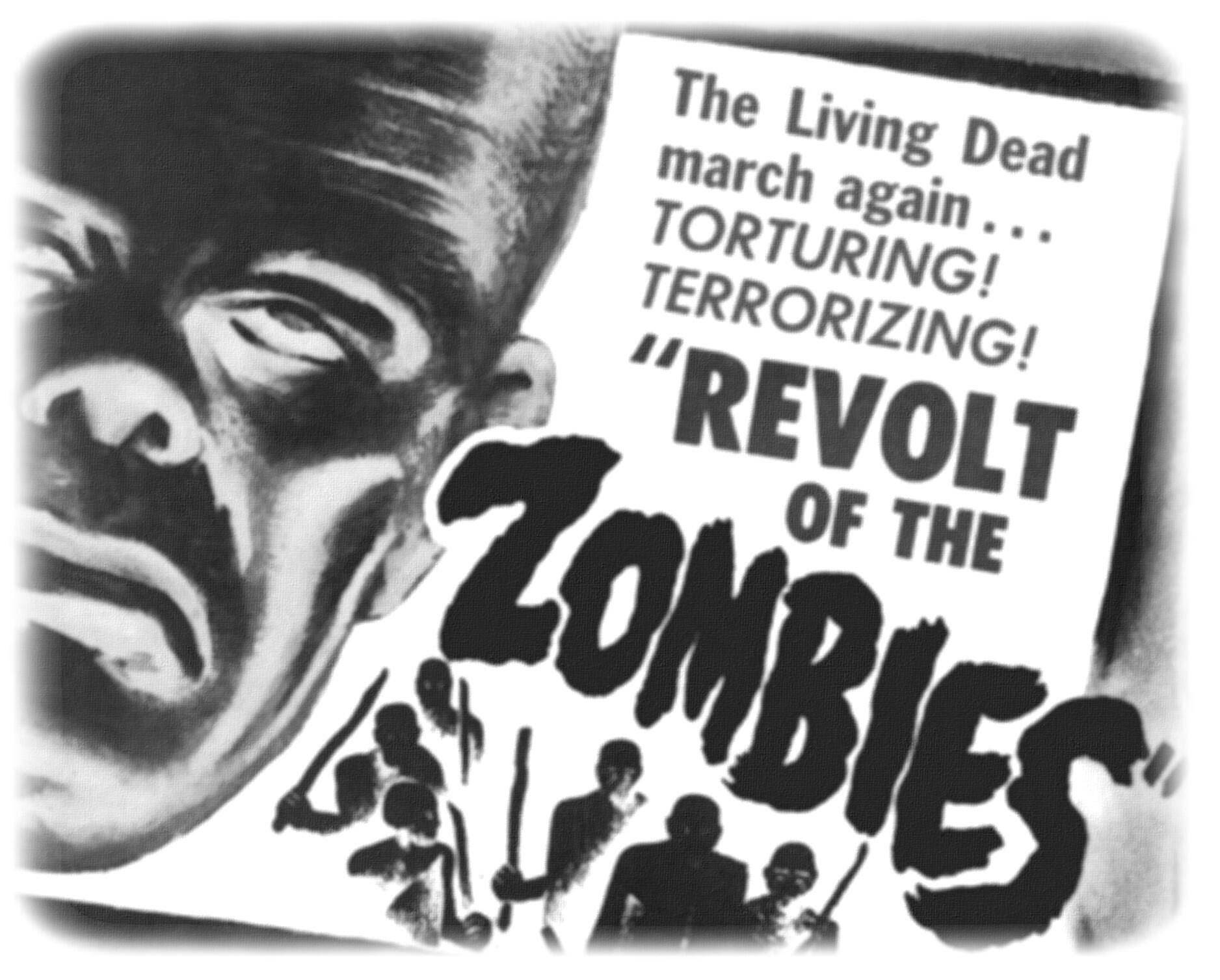 ‘The living dead march again’ screams this lobby card yet the movie belies it. Moral? Never trust a lobby card.
‘The living dead march again’ screams this lobby card yet the movie belies it. Moral? Never trust a lobby card.
In the spate of zombie films that followed, especially in the 1940s when horror films diverted audiences from the real horror of the Great War II, the zombie mutated to become a flesh eater. Nor was it any longer necessary to die first before dining on the flesh of others. Zombieism became virus passed by touch or bite, taking a tip from Dracula, a nip. In the Cold War, the soulless Zombie got red.
For further details see….‘I Walked with a Zombie’ (1943), ‘Revenge of the Zombies’ (1943), ‘Zombies on Broadway’ (1945), ‘Valley of the Zombies’ (1946), ‘King of the Zombies’ (1953), ‘Voodoo Island’ (1957), ‘Zombies of Mora Tau’ (1957), ‘The Dead Live’ (1961), ‘Voodoo Swamp’ (1961), ‘The Plague of the Zombies’ (1966), ‘Dawn of the Dead’ (1978), ‘Zombie Flesh Eaters’ (1979), and more. Oh, and the personal favourite of the fraternity brothers, ‘Cockneys versus Zombies’ (2002). No doubt there a PhD dissertation or two charing the mutation of the concept of the zombie and its influence on…..
‘Le Orme’ (1976) or ‘Footprints on the Moon’
IMDb runtime 1 hour and 36 minutes, rated 6.8 by 1184 masochists.
It opens ever so slowly with a moon landing, then cuts to one space-suited astronaut dragging another across the surface of the moon, only to abandon the dragged body and ascend in the LEM. Meanwhile, bug-eyed as always, Klaus Kinski is shouting into a microphone at what looks like mission control. Who would put Klaus in charge of anything! Keep that man away from the matches!

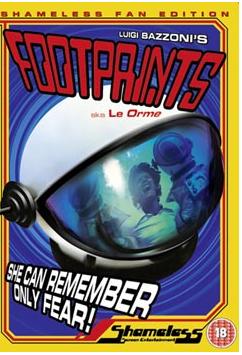
Then we turn to Alice, a translator in Rome, who goes off the rails. She misses days at work without herself noticing it. She finds things in her apartment of which she has no memory. She has lost an earring somewhere, somehow. All of these things she mentions to her friends who tell her to get some rest.
Because she found a postcard from Garma without a message on it in her apartment, she heads there, a remote and obscure location we are given to understand. When she arrives it is all but deserted in this resort for it is out of season. There she meets Beau, annoying Brat, and Lila. It seems she has been here before but everyone there knows her as Nicole. She also finds the missing earring. Thus the audience is sure she has been there before, even if she still is not.
Alice remains positive she has never set foot in the place, yet when Nicole’s clothes are presented to her they are a perfect fit. And so.
Brat tells her Nicole was on the run. Beau hangs around. Alice has recurrent images from that moonwalk and abandonment. She buys a second pair of large, and — no surprise — lethal scissors. The only reason she buys them is to have them handy later, it would seem.
It is a nice set up and then it is repeated for the next hour or so. Oh hum. It put the fraternity brothers in mind of ‘L’année denier à Marienbad’ (1961) though less glamorous. The repetition is eased by some very dreamy photography of Garma, about which more later, and an elegiac musical score.
Florinda Bolkan as Alice or Nicole carries the weight well enough but she has little to do but look perplexed. But she does not materialise from the screen like Delphine Seyrig.
It was released in one of its edited versions on DVD as ‘Primal Impulse’ in an effort to attract an audience by arousing expectations irrelevant to the film. Another triumph from a marketing department.

Completely misleading though the title is.
Spoiler.
After investing an hour and a half of watching and trying to fathom Alice’s predicament the end is a royal cop-out. After so much brain taxing the fraternity brothers were exhausted and then upset to arrive no where. Do not bother to look for meaning because there is none. The closing title card says Alice is a psycho to be confined to an asylum in Switzerland. End.
Guess where she left the scissors. No not in the Brat. But Beau is no more.
The visuals are striking, including the last scene on the pebble beach, but pointless.
Remote and obscure Garma was Kemer on the south coast of Turkey, hence the mosques and Arabic script on buildings. The sequences in Rome were filmed in the EUR district which is as unRoman as possible with glass, pre-fabricated cement and steel office blocks, and a grid of streets rather like La Défense in Paris. Everywhere the Romans went they laid out orderly cities with wide streets in rectilinear alignments. But not in the rabbit-warren that Roman itself remains.
The film has not been well served by time and tide. It failed to get many theatrical releases. Its production is unclear. One source says it was filmed in English and then dubbed into Italian. Then in an effort to get a theatrical release in the Anglo markets the Italian version was dubbed into English. Likewise, it was re-edited. None of these efforts bore fruit. It more or less disappeared for a generation.
Then some enthusiasts came upon it and have since gathered different versions and spliced them together, and one such example is what I watched on You Tube. It is indeed confused. The English dubbing is occasionally dropped and we have a scene in Italian, at other times there are Greek subtitles with English dubbing, and on still other occasions French dubbing with English subtitles. Variation also applies to the title cards, some in Italian and some in English. I compared two of the several versions available on You Tube and confirmed the observation that scenes have been edited out of some versions.
The critics linked to the IMDb site agree that these changes do not alter the substance, which is ethereal, insubstantial, and vapid.
‘Giallo’ is the Italian word for mystery stories like this, but knowing that did not help.
It came up in You Tube searches for Sy Fy because the references to the Moon, and at the outset it looked like a Moon mission was the key.
In the end it seems these early and recurrent images of the Moon mission came from a movie young Alice saw as a child, which frightened her, because one living astronaut was abandoned on the Moon, so that she ran from the cinema without seeing the end. Ergo, neither do we see the end. We never do find out what Kinski was up to but then he never knew either.
It was intriguing to watch with the eye and ear candy, and a change from elderly male actors slugging it out with CGIs. which is too much Sy Fy these days.
‘City of Gold’ (1992) by Len Deighton
Cairo, May 1942. The Desert Fox is a hundred miles away or less. Where? No one is sure. But close. Of that everyone is sure. Despite prodigious efforts the British have been unable to staunch Erwin Rommel’s relentless advance.
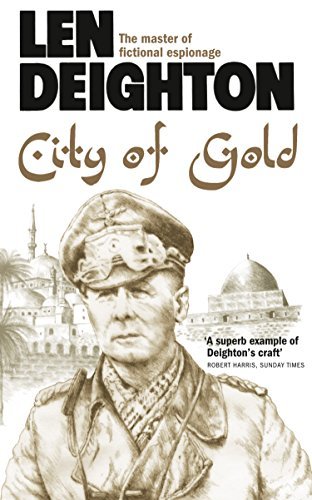
Egypt is a sovereign state with its own army, but it is neutral in this struggle. Its sovereign, the boy-king Farouk I, has invited the British to Egypt to protect the Suez Canal. Well, that is diplomatic fiction. The reality is that the British have occupied Egypt to protect the Canal, and thought it best to retain the façade of Egyptian sovereignty by leaving the king on the throne in the hope of stability in the rear.
Nationalists in Egypt are ready to welcome a Rommel victory as the means to end British domination and the corrupt local elite that thrives on that domination. Members of the Egyptian Army plot to that end, though there are many divisions among them.
British soldier Jim Ross arrives in Cairo in the custody of an MP who dies of food poisoning unexpectedly and quickly, and Ross switches places with the dead officer as a means of escape. But once in Cairo he is mistaken for that officer and soon finds himself growing into the role. That is a nice twist, and it is well realised.
Ross’s assignment is to find Rommel’s spy in Cairo who is feeding the Desert Fox very detailed information about the British forces, deployments, morale, weapons, Egyptian nationalism, shipping in the Canal, promotion of officers, developments in the Sudan and more. Ross discovers he has a penchant for reading files and making inferences.
Into the mix come many others. There is a resident white Russian prince, a widowed nurse, a Jewish gun runner for the Haganah, Ross’s superior and subordinate officers, and the comely Alice who finds him a man of alluring mystery. Throughout is the rogue Wallingford, a man of infinite charm, bottomless self-confidence, utter audacity, and who is amorally unscrupulous enough to go into politics. Even with a gun to his head, he continues to bargain.
Each character has a personality, but the sharpest is certainly Sergeant-Major Ponsonby who runs the office, and much else. In a complicated set of circumstance Ponsonby is forced to comply with the request of the arrogant women, the wife of a high ranking officer. Meekly he does so. Then, in a phrase Ross learns to respect, Ponsonby makes ‘a few inquiries.’ The woman’s request, though granted, seems thereafter never to progress through the works. At every stage it is misplaced, misfiled, mis-stamped, mis-signed, or mislaid. In the end Ponsonby is proved right, what she wanted was a bad mistake, and he explains the delays in action to Ross by saying ‘the SMs stick together.’
There are also vivid portraits of Egyptians caught between the worlds of the past, the present, and the future. Though the reaction of one Egyptian seems mistaken to this reader. His enemy was the king not the nationalists, but plots must have their devices.
The source of Rommel’s spy is adroitly handled, and is evidently historical fact, though it was all news to me (again). Though the plot device creaked here in the person of Percy, the ersatz South African.
For those that must have it, there is also one skirmish as the Germans advance, and Ross is in the wrong place at the wrong time.
Len Deighton’s name on the cover is always a guarantee of high quality plot and prose.
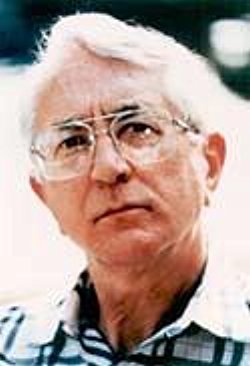 Len Deighton
Len Deighton
————
After false starts with some krimis I wanted something to read that I could and would read, so I turned to an old reliable. While sure I had read this before, I remembered nothing of it, not even as I read it. Hmmm. In any case it lived up to my hopes, it was engaging, informative, amusing, and enlightening with a story, a plot, characters, and such that the krimis that I had aborted did not have.
‘Eyes behind the Stars’ (‘Occhi dalle stelle’) (1978)
IMDb: 1 hour and 32 minutes of Dali time, rated 3.7 by 280 relatives of the actors.
A photographer and a model are in the English countryside doing a fashion shoot. Much snapping in a sunny lea occurs, then for a change of mood they enter a darkling glade, and after a few minutes there is off-camera heavy breathing. No, wait that was the fraternity brothers on the sofa.

Well, yes there is heavy breathing on the soundtrack, and we get a distant fisheye view, the first of many, of the twosome. They then feel creepy and scoot.
Back in his home dark room, the photographer develops the pictures and sees….! (Well, maybe it was David Hemmings from ‘Blow-up’ [1966] because it starts the same way). I was never quite sure what we were supposed to see in the photographs since they were out of focus as was most of the film, but latter it is declared that there were ETs on the snap. Ok, those with the script should know.
The snapper has a haircut like an unclipped Puli or maybe two Beatles’ wigs one atop the other. With that hair he cannot be too bright, and to prove the point in the dead of night he returns to the glade. Guess what happens to him!
Yep, the ETs get him, though not without a fight in which a local farmer and his dog are casualties. Thereafter the body count increases. Puli is on board the saucer and the twig-thin and short ETs in grey, polyester, and knit onesies with opaque blue visors set about him. These rompers are stompers!

Boy, can he bug his eye out! Boy he had reason to do so! See the size of that probe! Yikes!
Efforts to find a picture of the ET onesies failed. The conspiracy of silence applies even to that!
Puli had left a message for Eye Candy of his idiotic plan for a nocturnal visit to the glade and she turns, as one does, to the nearest blood sucker from the media, who sets about making matters worse.
Thereafter it is a race to see who can destroy the evidence of the ETs first, the ETs themselves with their fisheye views and heavy breathing, or the conflicting forces of order: police, detectives, military, secret service, and the men in black. Yes there three men in black and without the moral compass of a pug they go crazy. The forces of order want to suppress the ET news to avert panic and have been doing so for two generations. Well done, chaps. They spend a lot of time arguing among themselves about KPIs.
The ETs may have their own agenda but there is no communication with them. We are left to fear the worst, McKinsey managers! They just breathe and gander while themselves knocking off bystanders. The body count rises as both sides seek the pictures and then the negatives.
Spoiler alert!
It does have a twist in the tail. When Blood Sucker has the facts, the men in black, not wanting to be outdone on the KPI of bodycount, kill him and his two or three, I lost count, abettors along with Eye Candy in a hail of sound effects!
The end.
Moral? Do not cross men in black without a pug.
The closing title assures us that this story is based on fact. How so since most of the principals are dead is anyone’s guess? Did the the men in black kill-and-tell?
It is an Italian production set in England with German and American actors as well as Italians. While the number plates are English and there is Land Rover much in evidence neither this vehicle nor any of the others are left-hand drive. The American is dubbed with a Scots accent, sometimes. The German speaks German and is dubbed with a mumble.
Italians have been trying to pretend they do not have an ET problem by projecting such tales on to England, but Silvio has been a dead give-away.
